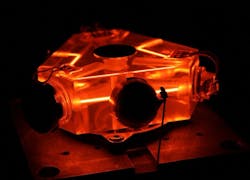Navy lets Honeywell contract to supply ring laser gyros for navigation and guidance aboard surface warships
MECHANICSBURG, Pa. – U.S. Navy shipboard navigation and guidance specialists are continuing their efforts to squeeze all the life they can out of the AN/WSN-7 ring laser gyro navigation system for Navy surface vessels and submarines.
Officials of the Naval Supply Systems Command Weapon Systems Support activity in Mechanicsburg, Pa., announced a $12 million last week to the Honeywell International Inc. Aerospace segment in Minneapolis to provide ring laser gyros for the AN/WSN-7 inertial navigation system.
The AN/WSN-7 is a self-contained, ring laser gyro inertial navigation system that senses ship motions, computes the ship's precise position, velocity, attitude, heading, and rates in digital and analog formats, and forwards the data to other vital ship systems.
The WSN-7 has been in service with the Navy for decades, and was designed as a replacement for spinning-mass gyro navigation equipment aboard Navy warships. The system is as a more reliable ring laser gyro-based replacement for the old WSN-2 navigation system.
Navy officials are extending the life of the WSN-7 as long as possible as they develop a WSN-7 replacement.
The Northrop Grumman Corp. operating unit in Charlottesville, Va., provides the AN/WSN-7, and is developing the Inertial Navigation Systems Replacement (INS-R) Inertial Sensor Module (ISM) as a replacement for the WSN-7, to enable surface vessels to navigate accurately without GPS satellite navigation.
Northrop Grumman reported completion of the ISM's preliminary design review in May 2016, and critical design review in June 2018. The ISM will be a critical component of the WSN-12 replacement.
The INS-R will provide mission critical ship positioning, velocity, and altitude data to shipboard sensors, combat systems, guns, and missile systems. It will use an open-systems architecture using a modular design, standards-based interfaces, and widely supported consensus-based standards.
The AN/WSN-7, meanwhile, uses 25-year-old technology based on the NATO MK49 inertial navigation system deployed in the late 1980s. The INS-R will provide improved real-time navigation for Navy surface warships, and enable future technology growth.
The standard WSN-7 shipboard configuration consists of two independent cabinets for redundancy and survivability. It is not be susceptible to jamming or detection by enemy forces.
Related: Northrop Grumman keeps Navy shipboard navigation running while looking for new technologies
The ring laser gyro uses two counter-propagating laser beams operating on different frequencies with the difference dependent on rotation rate. Measurement of this difference provides the rotation angle or rotation rate about the device's sensitive axis.
Compared with older spinning-mass gyro navigation systems, ring laser gyros are much smaller, do not resist changes in direction, are frictionless, have low power consumption, and feature almost no moving parts to enhance reliability while still providing adequate accuracy.
On this order Honeywell will do the work in Minneapolis, and should be finished by April 2024. For more information contact Honeywell Aerospace online at https://aerospace.honeywell.com, or the Naval Supply Systems Command Weapon Systems Support activity at www.navsup.navy.mil/NAVSUP-Enterprise/NAVSUP-Weapon-Systems-Support.
About the Author
John Keller
Editor-in-Chief
John Keller is the Editor-in-Chief, Military & Aerospace Electronics Magazine--provides extensive coverage and analysis of enabling electronics and optoelectronic technologies in military, space and commercial aviation applications. John has been a member of the Military & Aerospace Electronics staff since 1989 and chief editor since 1995.
